2016 K2 Pinnacle 130
Ok the Lord of the Rings reference may be a bit much but on paper the K2 Pinnacle seems to have everything you could need from a boot, so could these be your last boot ever?
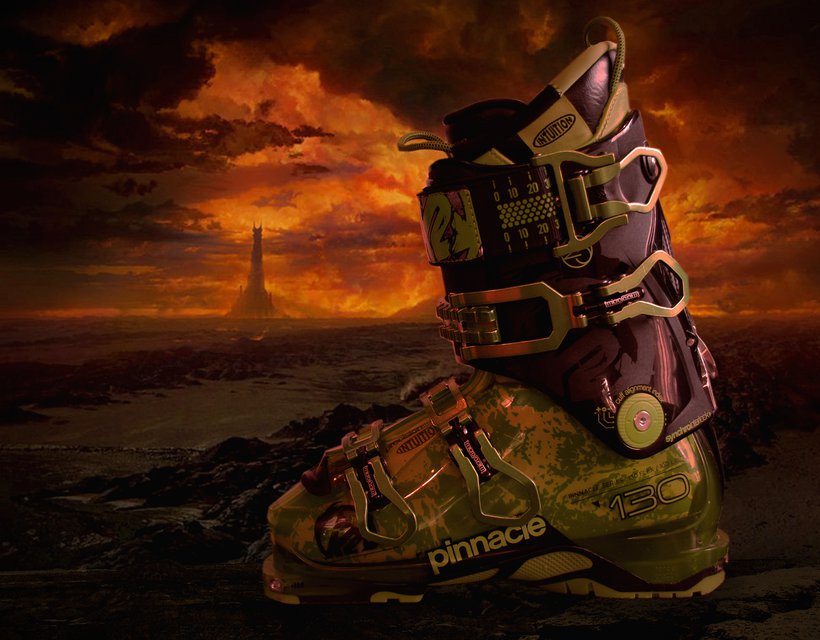
Next season will mark the third year of K2 producing ski boots and although I have fitted and sold them for the two years they have been on the market this would be my first opportunity to put the boots through their paces.
K2 produce two lines of boots, the Spyne (Spyre for woman) an all mountain boot with a fixed cuff, and the boot I would be testing the Pinnacle (Minaret for woman) which is the freeride offering with a ski/walk mechanism.
Both lines are available in various flex's from 90 to 130 for men and 80 to 100 or 110 for woman. Perhaps more interestingly the higher end models are offered in a range of fits from Low volume at 98mm right up to the High Volume at 102mm.
I would be testing the top of the line Pinnacle 130 in the Medium volume which has a 100mm last. This version has some pretty impressive features such as Tech binding inserts in a Din compatible sole and Intuition liners customized by K2, but how would these relatively new boots stand up against boots from companies who have been doing this for decades.
Firstly though I want to mention one thing, no doubt if you pick these boots up the weight will be the first thing you notice. These are no light weight touring boots but that is not what the designers wanted to make. Their aim was to create the ultimate freeride boot, a boot the best riders could use in the biggest of terrain. If your looking to do multi-day backcountry missions these are probably not the boots for you, but if your backcountry is more ascending to find some gnarly terrain then keep reading.
Technologies
Interlock and Powerfuse Spyne
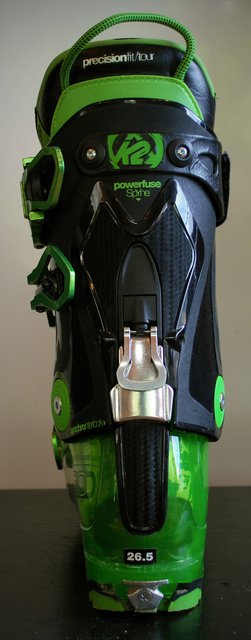
Running through both the Pinnacle and Spyne boots is one key idea witch set K2 boots apart from the competition. Most Boots use bolts or rivets to connect the cuff to the clog, like the Rossingnol Allspeed 120 I reviewed last week. These bolts help make the boots stiffer and give the boot a more consistent flex. However using bolts does cause stress on the cuff in the place the bolts are located.
Because of this instead of bolting or riveting the cuff, K2 use their Interlock system. The basic idea is to connect the cuff and the clog without any bolts or rivets so that the stress is more evenly spread through the back of the cuff. The cuff and clog are connected with interlocking plastic inserts, which K2 think better distribute the stresses more evenly.
Along with Interlock K2 use what they call a Powerfuse Spyne. Although it sounds complicated it is basically a injected section in the back of the cuff which Carbon Fiber is added too. This helps strengthen and stiffen the cuff and K2 also claim it helps with the rebound of the forward flex.
Reading the information I must admit I was a little skeptical about K2's claims of the improved feel by using interlock rather then the standard bolting but the theory did seem sound and I'm always interested to try new ideas.
The Powerfuse Spyne I did think had promise. I am a big fan of the use of Carbon in the cuff, for example in the Atomic Waymaker Carbon 130, so I was hopeful these boots would offer a similar powerful feel.
Powerlock buckle
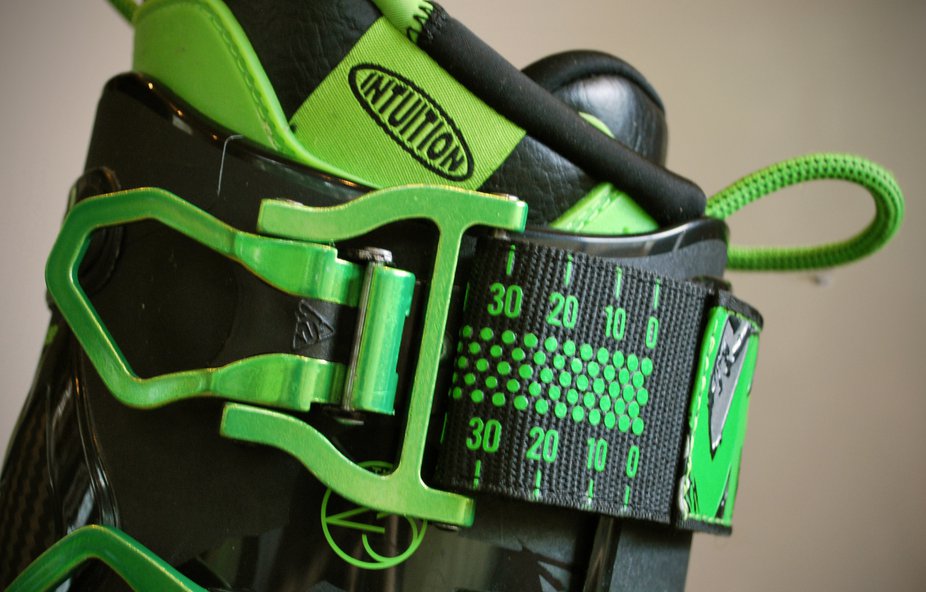
One feature that is exclusive to the Pinnacle 130 is the Powerlock buckle. In essence it is a power strap which you close using a buckle rather then just pulling it tight. With only 1 standard buckle on the cuff the Powerlock buckle means that the strap acts more like a second buckle but with all the benefits of a standard power strap.
Along with giving a firmer fit compered to a regular power strap the buckle gives the ability to easily loosen the strap when you want some more mobility in the cuff, such as when your touring. You can open the buckle to loosen the cuff but re-tightening is as easy as flipping the buckle down again.
I like the concept of this but I was interested to see how easy it would be to get the right tension.
Tech Compatible Din Soles

This is probably the Pinnacles biggest selling point. It is the only boot currently on the market which is compatible with all binding options. On the same day you could use a Dynafit tech touring setup and your good old FKS without having to change anything.
As standard the boots come with a replaceable sole which is Din compatible. As of next season K2 will be offering Vibram sole options for the pinnacle. Although these soles will not be WTR compatible they will work with tech bindings and the Marker Kingpin.
The tech insets are build straight into the shell so are not effected by changing the soles and should also offer a stronger interface then if they were included in a replaceable sole unit.
I would be testing these boots with a selection bindings including STH Steel, STH 2, Griffons, Radicals and the one I was most excited about, the Marker Kingpin.
Custom Intuition Liner
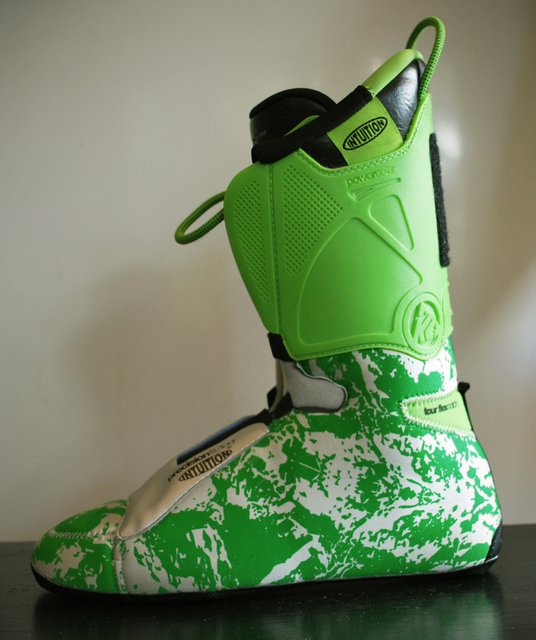
K2 decided to go with Intuition liners throughout the whole range of boots. The liners used differ slightly boot to boot but the Pinnacle 130 uses the top end PrecisionFit Tour liner.
Unlike the wrap style Intuitions used in Full Tilts for example, K2 decided to go with a standard tongue style liner. I think this is a good choice personally as I do tend to prefer the feel of a tongue in a boot designed to be ridden hard.
From a boot fitters perspective I was also very happy to see that K2 did not use a liner with foam beneath the foot. There is a standard firm base to the liner which makes fitting much easier.
One area K2 customized the liners is adding plastic to the cuff area. This reinforcement is designed to further improve the power transfer of the cuff. It does add some weight to the liner but does certainly give a firm feel to the cuff while still offering a comfortable fit.
On the back of the liner is a mid firm rubber spoiler (not pictured above). The spoiler is attached with Velcro so it is very quick and easy to adjust the position. The spoiler is quite big though so by having it in the forward lean will be increased quite a bit.
Ski/Walk Mechanism
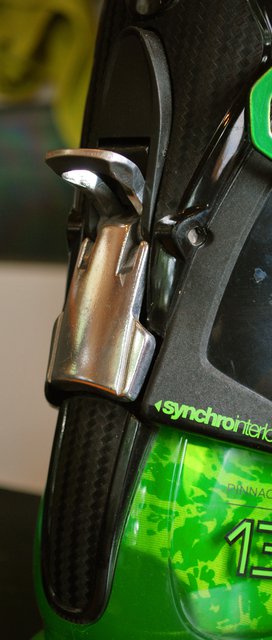
As I covered above K2 is using the Interlock system for the Ski/Walk Mechanism but I wanted to take a closer look at how it works.
The cuff is released in a similar fashion to most of the current freeride boots on the market. A wedge piece is used to stop the cuff flexing back when in ski mode. Inside the wedge is a square cutout which matches a raised section on the clog. This is the method K2 is using to lock the shell and clog.
Along with releasing the cuff to flex backwards, when in hike mode, the forward flex is also softened making it easier to achieve a natural walking movement. The way this is achieved is fairly simply.
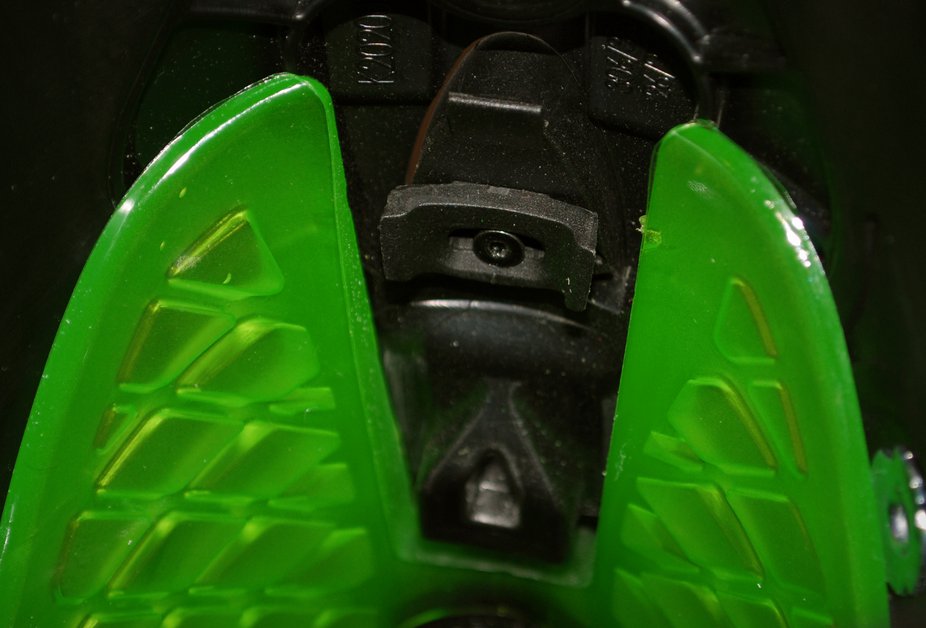
Some of you may have seen or even done a V shape cut in the back of a boot to soften the flex slightly. Removing a V shape allows the Cuff to flex over the lower clog more easily making the flex of the boot softer.
K2 have done a very similar thing, there is a V cut in the clog but when the boot is in Ski mode a small plastic piece moves forward to fill the gap, effectively removing the cut and stiffening the flex. When the boot is put into walk mode, this plastic piece moves back allowing the V shape to open and the boot can flex forward easier.
It is a simply idea but is very effective. The flex really softens when in walk mode and although the cuff does not go as far beyond vertical as some boots on the market the overall feel of the boots in walk mode is one of the best I have tried compared to equivalent boots.
The Rest
I always like to take boots apart when I get a new pair so that I can really get to know the boots. Often the amount you can remove is pretty limited but these boots are a boot fitters dream. You can fully remove the cuff, all of the hardware (buckles etc) are bolted on rather then riveted and everything comes apart very easily with very few tools, all of which are provided in the box.
This may not seem like a big deal but it does make the boots much easier to work on and if you have issues you could potentially fully rebuild the boots at home if you had the spare parts.
Speaking of spare parts this is something K2 is doing very well. Everything is available free of charge after original purchase and many of the parts are interchangeable between models meaning if certain model parts become unavailable you should still be able to get a part which works.
The boot board is a soft rubber in the Pinnacle series, whereas the Spyne uses a rigid boot board. The boot boards are interchangeable between the models though, so you can take your pick on which you want to use. A softer boot board added to a Spyne could make them a great option for the park.
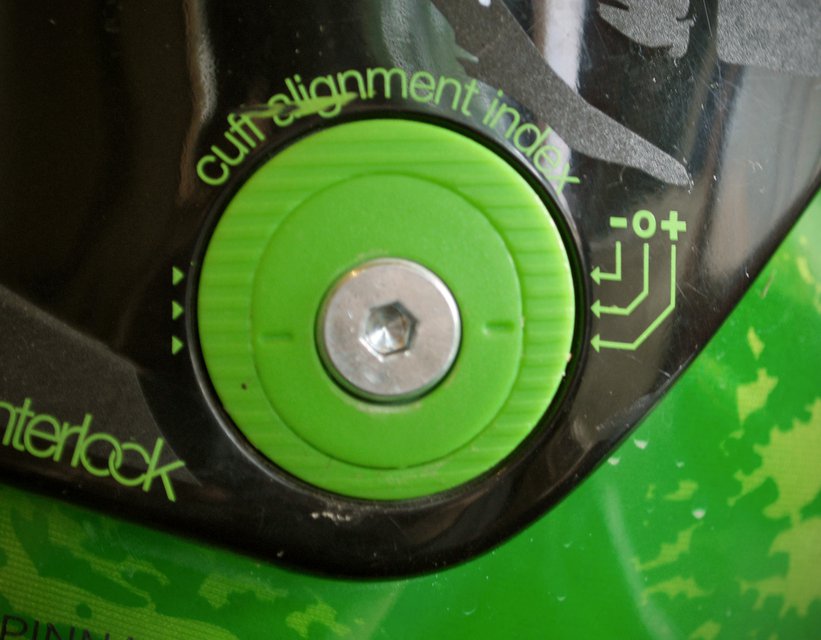
The cuff features dual cuff alignment which works in a very similar manner to that used on some Full Tilt and Dabello boots. The way it works is very simple, the adjuster is built from 2 plastic pieces each with an offset hole. The smaller piece goes in the larger and the cuff bolt goes in the hole in the smaller one.
Arranging the pieces so the offset is in different potions allows for a total of 4.4degrees adjustment which is pretty good. On a boot this price I would have liked to see these parts be metal to add durability but plastic has been effective in this area on other boots.
Overall although the boots have not technically changed I do think the 2016 version looks better then the current season version. The way a boot looks hopefully should be a very small factor in the decision process but hey if a boot can look good as well as ski and fit well that is a bonus.
The Fit
For 2016 the Pinnacle 130 will be offered in Low (LV), Med and High (HV) volume options which at 98, 100 and 102mm should cover a good section of the market. It was always annoying having your boot selections be limited by fit so I think the fact companies are now offering the same boot in various fits is great.
As I said above I would be testing the 100mm version and initially shell checking the boot I would say its more on the roomy side. The instep is not overly high and the forefoot and toebox are a decent size for a 100mm boot but the throat of the boot is rather high volume.
K2 have done some things like adding space for the navicular (bone on the inside of the foot) which can often be painful but for me it does add to much volume in that area. I'm all for companies taking work away from me but I do think some stretches should be left to a boot fitter.
One area which is quite low volume is the heel. I do not have a particularly high volume heel but the shell is rather tight on my foot.
I would be testing the boots in size 26, in this size they have a BSL of 306mm which is fairly standard for boots this size. Shell check wise if anything they are on the larger side but this is partly to do with the decent sized toe box with plenty of big toe room, something I often struggle with.
If I'm being honest I would say I was a little underwhelmed by the fit of the shell. There was nothing really wrong with it but it did not seem to have much overall shape.
The liner however really changes things.
This would actually be the first pair of intuitions I have used and once molded they did give an excellent fit in the shell. They initially felt a little tight on my instep and heel but I decided to leave it and see how they bedded in.
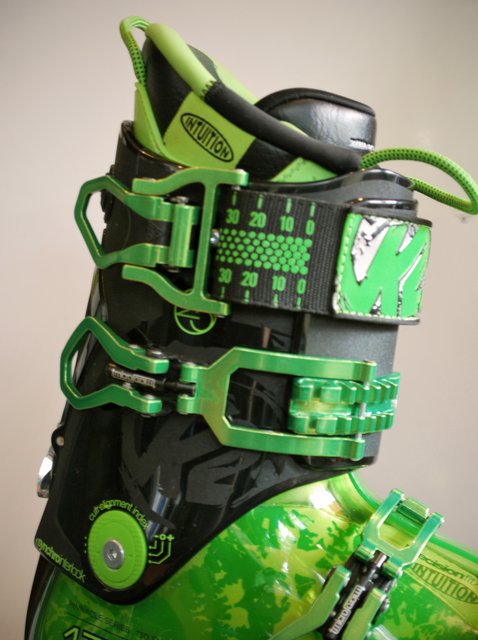
One thing I had found fitting these boots for customers was the cuff fitted rather large. I often had to move the buckle teeth inwards for people to be able to get a snug fit and this was something I found on my test pair.
On the first try I was finding I was having to do the buckle to the last of the teeth. This was an easy change to make but I have not had to move the buckles on any other boots I have tried this season.
Having fit options is always good when it comes to boots and having boots with larger volume cuffs is very useful at times but I do think K2 could slightly redesign the cuff to reduce volume.
Like the shell I also felt the liner lacked some volume in the cuff. The calf section felt OK but the tongue is very thin. The Intuition foam still gave it a snug, comfortable fit but I did wonder how my shins would feel after a few days in the boots.
Other then adding my footbeds and molding the liners I did not have to do any work before taking them out for there first few days on the hill.
The Ride
All Mountain
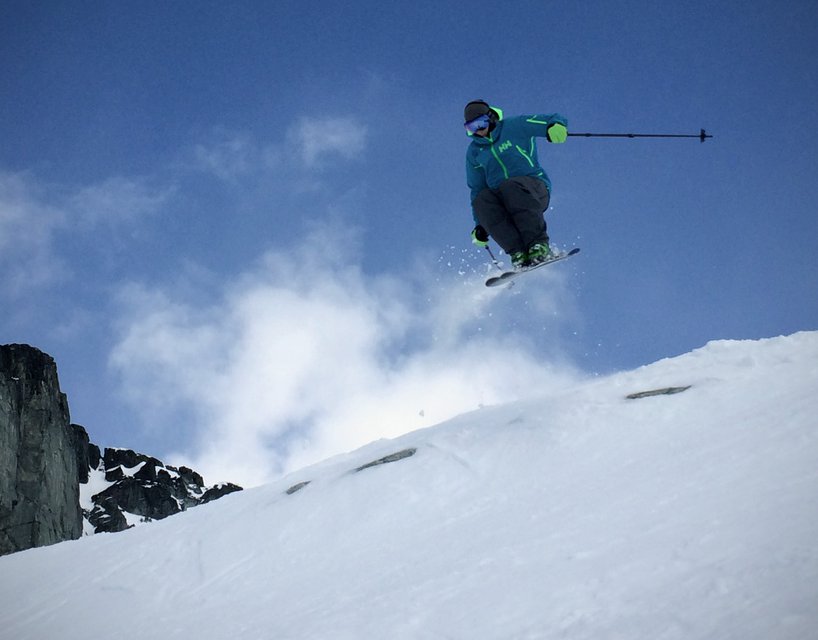
My first few rides in the boots were just general riding around the mountain. We have had a pretty awful snow year here in whistler and the snow pack at the time I was initial testing, was firm to say the least but this did give me opportunity to push the boots hard.
The forward flex is firm, they are certainly some of the stiffer freeride boots currently on the market. They are no race boot 130 like K2 claim but you can certainly lean into the boots.
The lateral stiffness felt good but not as stiff as some boots I have used. One thing I did notice was there seemed to be a slight mismatch in forward and lateral stiffness. The boots feel slightly stiffer forward then side to side something I would personally prefer to see reversed. I like a boot to be stiff side to side but with some forgiveness forward to help with impacts.
One thing I did notice was a slight movement in the cuff. I was finding that there was a small amount of play forward and backward. The walk mode was engaged correctly and the wedge was working but there was still a slight amount of give.
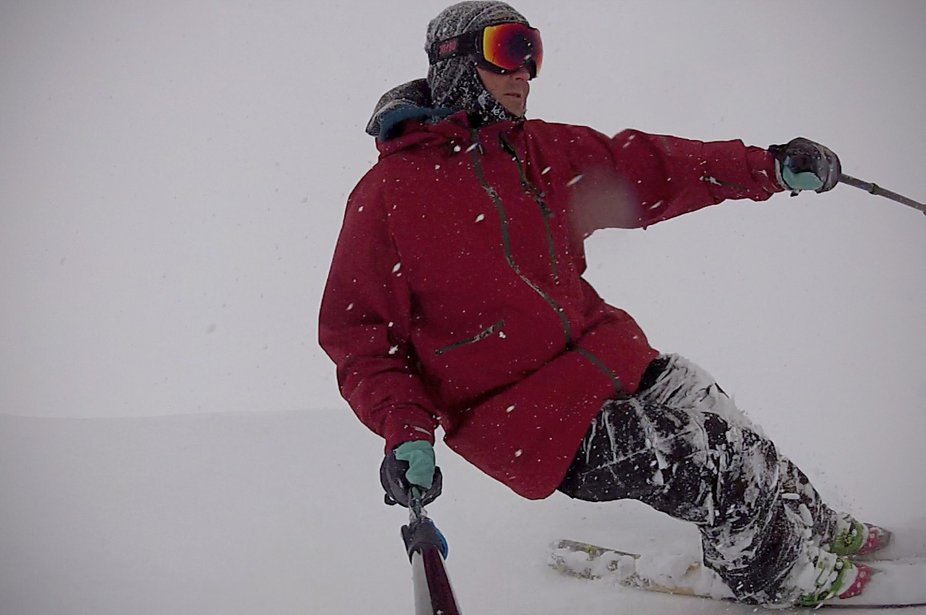
The fit did soften up slightly and I found the instep pressure disappeared pretty quickly. I have become a big fan of the liners, I have heard for years how comfortable and warm they are and I now see why so many people like them.
They have offered a comfortable, consistent fit and even though they feel soft they still allow a good amount of energy transfer. I am seriously considering getting Intuitions for all my boots after testing these.
I did find sometimes that the lack of volume in the tongue was slightly uncomfortable after a long day and I would like to see k2 build up the tongue in future versions.
I also think the spoiler pushes you slightly to far forward and would prefer a thinner rear spoiler and a thicker tongue to give a slightly more upright stance.
So as far as the resort the boots were fairing very well but that is only one aspect of this boot and to really test them out I wanted to take them touring.
Backcountry
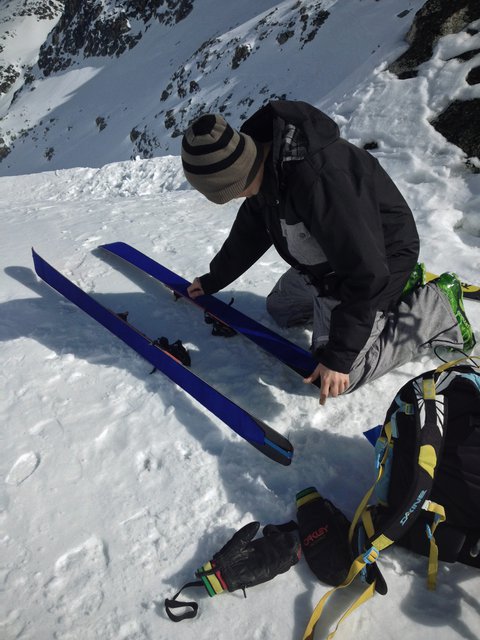
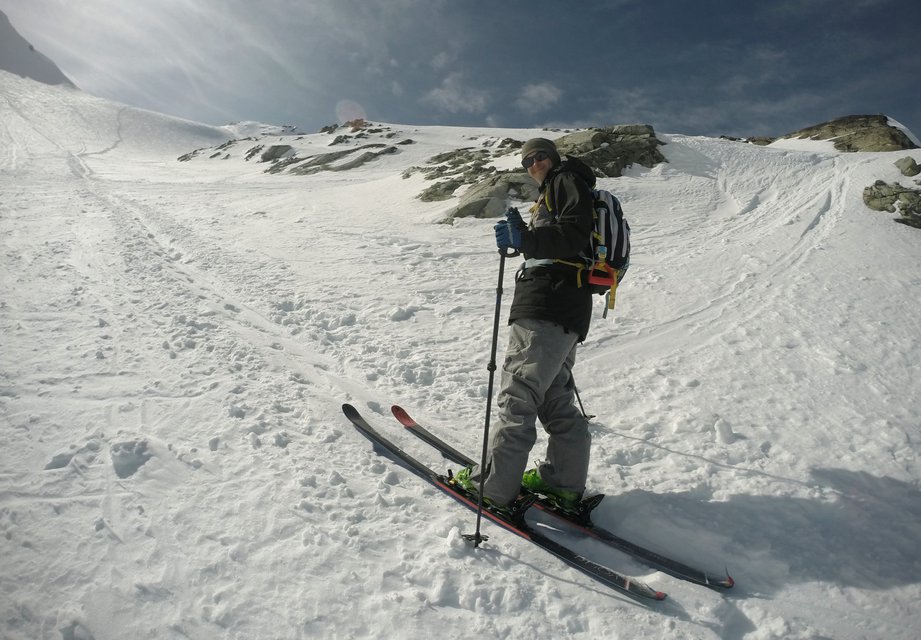
As I mentioned at the start these are certainly no lightweight boot so to help my legs, I wanted to try and save as much weight as I could with my Skis and bindings. I decided to go with the Volkl BMT 95 and the Marker Kingpin. Although admittedly not cheap this is the perfect kind of setup for these boots. If you get a hard charging, lightweight ski and binding you can really get the most out of these boots.
The ascent we would be doing was from the backcountry access gate on the Blackcomb glacier, climbing up to access Bodybag bowl. Although not a long ascent we would be traversing our way up for an hour or so which would hopefully be enough time for potential problems to arise.
With both boots set to walk mode we set off up the ascent. The heels were still feeling tight so I had decided to tape my heels in anticipation of problems but luckily even with the foot buckles undone the boots felt nice and snug and my feet were not moving around. By the end of the climb my heels were a little sore but I do think with more bedding in and maybe a shell stretch they will be fine.
The liner is firmer in the heel which although giving a snug fit can take longer to bed in then the rest of the liner.
The Powerlock buckle did work well here, undoing the buckle does release the cuff but I did find that I undid the strap slightly more any way so I'm still not fully convinced of its benefits over a regular strap.
The movement in the cuff felt fine and I actually found at the top that both boots had actually reverted back to ski mode. The fact that I was still able to skin up fine with the boots in ski mode was quite impressive to me but I was a little worried about why the boots had reverted back to ski mode.
I contacted K2 and they had not heard of it so I put it down to user error and I have had no issues since this initial trip. It may be one area k2 could look at improving though.
Although the light weight skis and bindings certainly helped I really did not find any issues with the weight on the way up. If I was going to be climbing for hours for multiple days I would go for something lighter but for shorter hikes where the emphasis is the way down these boots will work well.
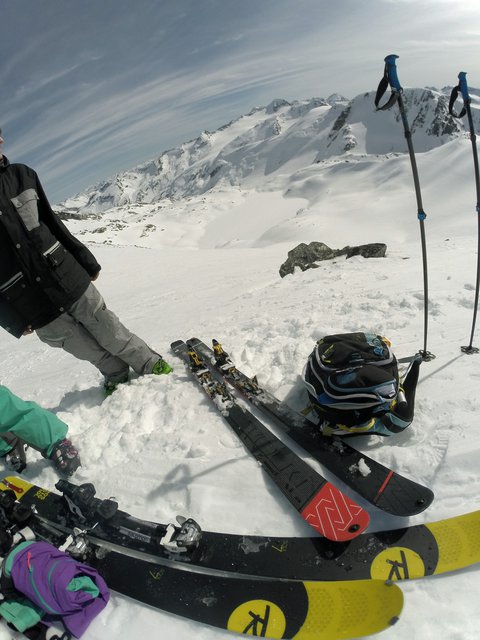

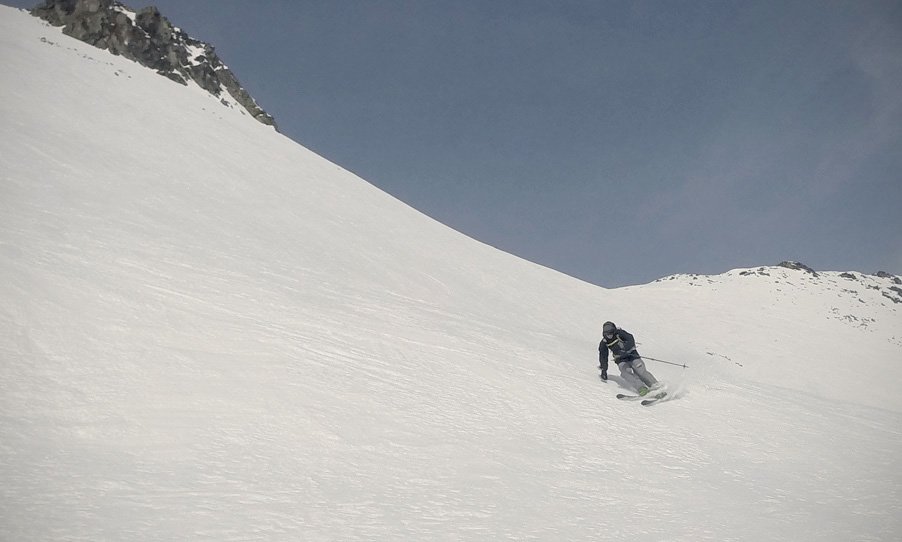
Once we had made it to the top, the boots really began to show there full potential. The snow was fairly firm and the skis were getting thrown around quite a bit but the boots really allowed me to drive the skis as hard as I wanted.
These conditions would have challenged a traditional tech setup and I certainly would not have been skiing as hard on a traditional tech setup and a big part of this was thanks to the kingpin. I will be doing a full review on the binding but they really do feel like an alpine binding. I was pushing them as hard as I would any other binding and they really allowed me to get the most of the boots. A Dynafit binding would not allow you to use these boots to their full potential, so I would recommend Kingpin's or frame bindings as the best matches for these boots.
Although these will not replace a light weight touring boot for longer missions if your main aim for hiking is to access some big terrain these are an excellent choice. They are comfy on the way up but as powerful as you will ever need on the way back down.
Park

Although these boots were never intended for the park, this being Newschoolers I thought it was important to see how they handled the abuse of the park.
On a slight side note, I do think its important for boots like this to consider the park in their design process. We have got to the stage with skis where we have skis that can handle everything from park to pow and although we are close to it with boots I don't think we are quite there. I would love to have a boot like this that can handle the park just as well as it does the climbs and big descents.
Having said that I do actually really like these boots in the park and its mainly to do with the fit. The roomy shell combined with the plush liner and soft boot board do a great job of reducing impacts. They have actually become of of my favorite boots in the park and its mainly down to how comfy they are.
For me the flex is fine but after a long day my shins do get a little sore. Again I think a more robust tongue would help here.
One problem I did find was the cuff play did get a worse. After a while the play in the cuff had become a bit of an issue so I decided to take a look and see what was going on.
The Cuff
Looking at the shells its hard to determine exactly where the play is coming from. There does seem to be a slight gap between the wedge of the walk mode and the lower shell so this may be where some of the play is coming from.
I think the main issue is more likely the way the Interlock system works. It works really well when the weight is forward but when the weight is back on the cuff, the system seems to loosen slightly. It is seemingly made worse by adding the moving parts for the walk mechanism and I have found no real play in the Spyne boots.
I do also think some of the play is coming from the plastic cuff adjusters, it feels as though the screw holes have deformed slightly further adding to the play.
While I was looking at the cuff I did notice something interesting about the plastic piece used to fill the V cut. It is slightly smaller then the V cut which means the initial flex is much softer until the V shape is filled by the plastic piece and the flex stiffens.
I was finding that this initial softness meant I was sitting slightly into the flex and I wondered if this was adding to the feeling of movement in the cuff.
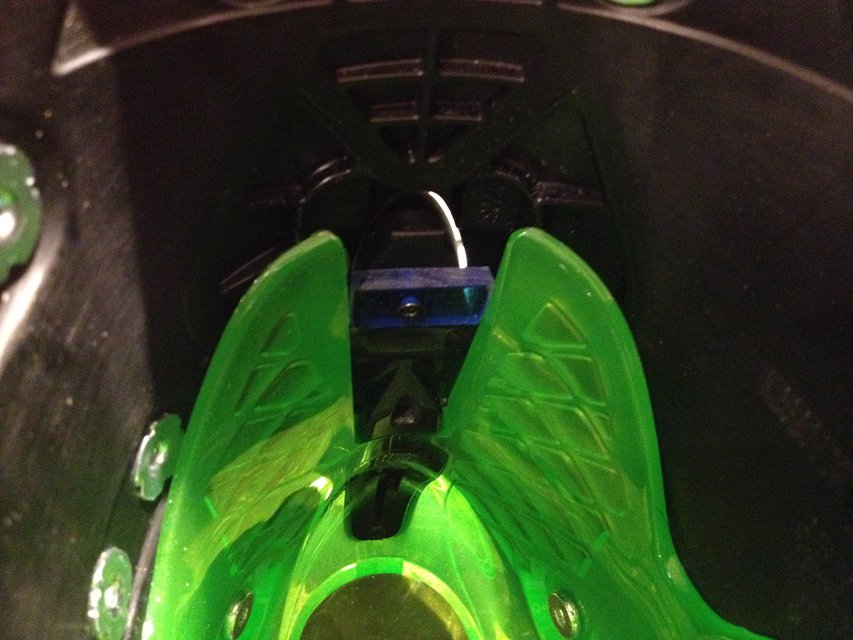
Looking at how K2 had built the wedge section I figured I could recreate it fairly easily but this time make it big enough to fully fill the gap, hopefully removing the initial flex.
My first attempts were made from wood and although looking very nice they both broke. I instead used the plastic from a wax scraper. Although very basic the conversion seemed to work very well. The cuff felt more solid and the flex felt more consistent as there was no initial soft flex. The small blue piece in the photo above is the part I recreated.
I got a few other boot fitters I work with to blind test it and they all said the modified version felt better in the cuff, even though they did not know what I had modified.
I never intended to ski it but it felt so good in the shop I figured I had to give it a try. I told my self I would take it easy as it could potentially break at any point, but that lasted about 30 seconds. The boot felt great and I very soon was hitting things just as I normally would. Personally I think the flex does feel better but it has certainly stiffened the boot up.
I got the chance to speak to the K2 boot designers to discuss the issues I was having and they did explain the reasoning for making the wedge slightly smaller. They were finding that when the boot was buckled tightly when still in walk mode, the V would close slightly and then a full size wedge would not work.
I do understand this and can see that the solution they chose was an effective one but I would like to see a more effective method of closing the V used in the future. Perhaps an angled piece which could push its way in when weight was applied forward.
I should also say at this point that I was initially skiing sample boots. Although not vastly different to the production models they are not quite the same and you should expect a few more issues.
K2 have recently supplied me with some 2016 production boots and the cuff is certainly better. There is still some play, although less then before but I still think there is room for improvement.
Overall
Having read that last section you may expect that I'm going to be quite negative about the boots but actually I really like them. I feel these boots have a lot of potential. The issues I found were small and chatting to K2 they are certainly not consistent with what they have found.
Its also worth noting that I was skiing samples and not full production versions until fairly late on.
I really like the idea of boots like these though, making a boot which is compatible with so many binding options straight out the box is awesome especially if you only want one pair of boots. It may sound like a small thing but being able to just put the boots on and ride any possible binding combination is great. Yes lots of boots have the ability to add tech compatibility by swapping the soles but that is just one more thing to do.
K2 have tried some new ideas and I think this is a good thing in the boot world. Some things I'm still not totally convinced by but some such as the Powerlock buckle are growing on me.
Overall the fit is great, I love the liners and the walk mode is one of the best I have used on a freeride boot but they are not without their problems.
I love the foot but the cuff needs work. I would like to see a redesign to try to reduce the play and also reduce some of the volume. In doing so if K2 could find some ways to shed some weight that would not hurt either but I think these are acheivable goals. With a little more development I really do see these being one of the top freeride boots available.
Of course there are quite a few boots in this market and as always with boots, fit should be the most important factor but having tried a number of this style of boot I do believe K2 should be right up there in your next boot choices.
Next week is the turn of the true backcountry boots. The touring Market has been dominated by brands like Scarpa and Dynafit for years but next season marks the launch of dedicated touring boots from Salomon and Atomic. To see if they are offering anything new I tested them directly against some of the current market leading touring boots and the results were surprising.
Check back next week to read my full review of the Salomon MNT Lab and the Atomic Backland Carbon boots.
Big thank you to Artie for being my guide in the backcountry
Review System
If you liked the look of any of the outerwear in the photos, it is all (excluding Helly Hansen which is coming soon) available to view in the Review System and as ever we want you to add your own reviews of any gear you have liked or even disliked.
Eira (Backcountry Photos)
Dakine (Red Jacket Black Pants)
Goggles
Gloves
Follow me on Instagram @tompietrowski to see what I'm currently testing

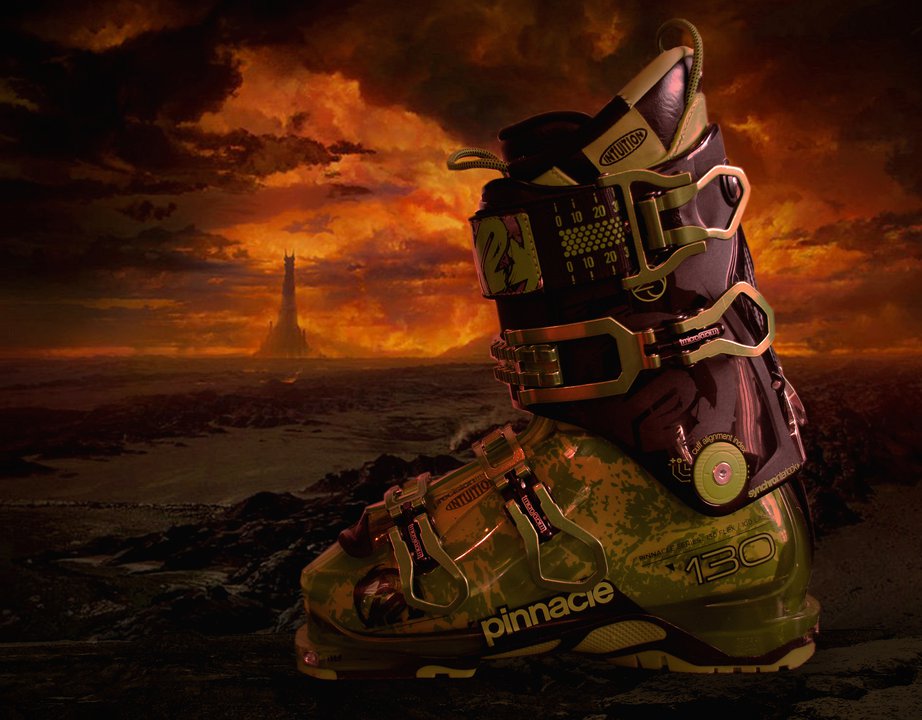
Comments